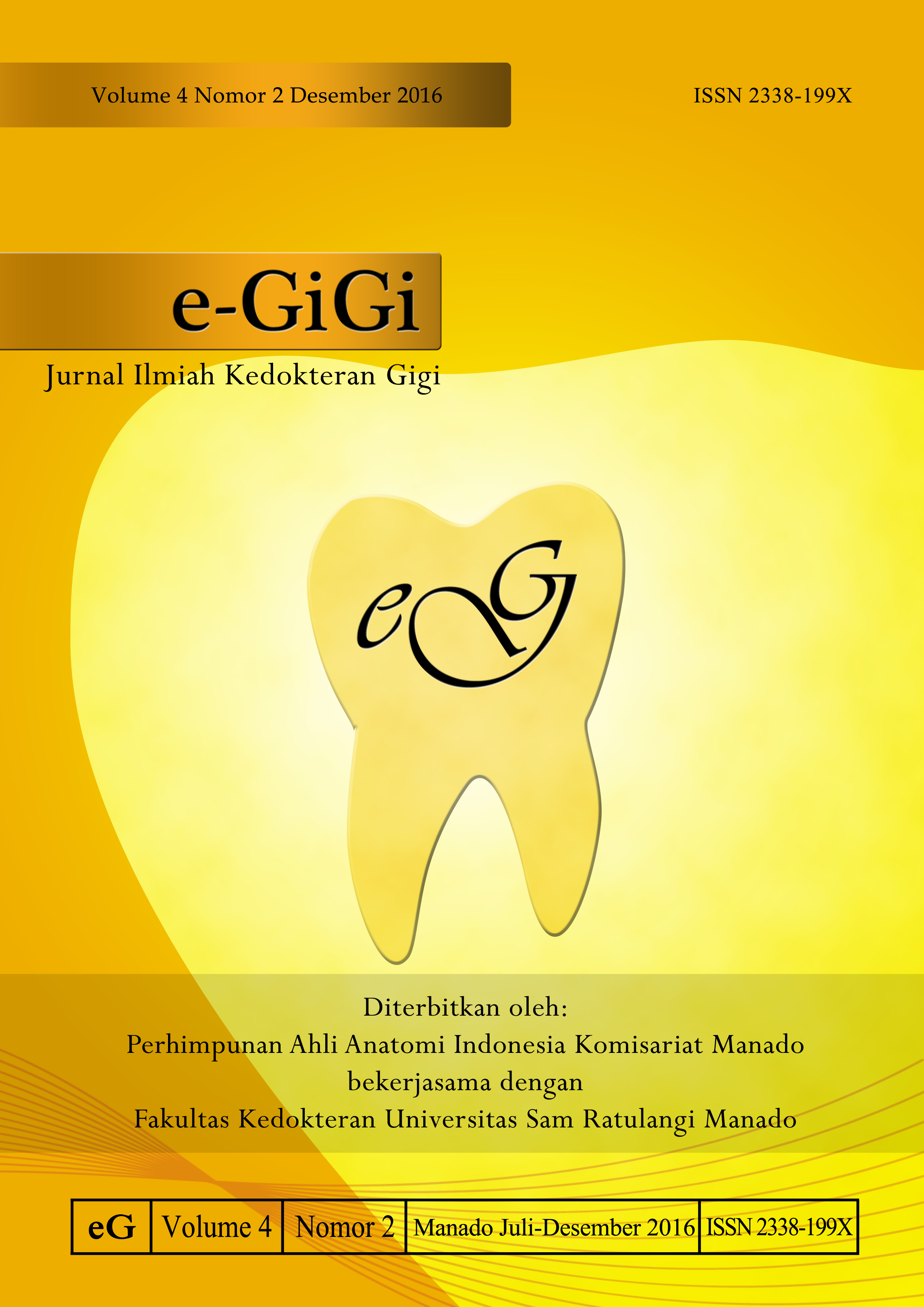Perbandingan efektivitas pemberian asam mefenamat dan natrium diklofenak sebelum pencabutan gigi terhadap durasi ambang nyeri setelah pencabutan gigi
DOI:
https://doi.org/10.35790/eg.4.2.2016.13650Abstract
Abstract: Tooth extraction is one of a minor operative surgery in dentistry that could cause uncomfortable sense of pain at its surrounding area. In order to reduce that feeling, some pain management could be performed, such as local anesthetic administration or analgesic medication. This study aimed to compare the effectiveness of mefenamic acid and diclofenac sodium given before the extraction procedure against the pain threshold duration after tooth extraction. This was a clinical study with a case-control design and was carried out in July 11th – August 12th 2016 at Department of Oral Surgery RSGM FK Unsrat. There were 30 samples obtained by using the purposive sampling method, divided into three groups, each of 10 samples, as follows: the control group without any analgesic treatment; the treated group with mefenamic acid; and another treated group with diclofenac sodium before the extraction. The results showed that the control group had a lower average of pain threshold duration than the treated groups with a difference of 2 hours and 42 minutes. The group treated with mefenamic acid before the extraction had the highest average of pain threshold duration compared to the group of diclofenac sodium with 4 hours and 11 minutes vs. 3 hours and 49 minutes. Conclusion: Mefenamic acid given before the tooth extraction procedure had greater effect and higher pain threshold duration than diclofenac sodium.
Keywords: tooth extraction, mefenamic acid, diclofenac sodium, pain threshold duration.
Abstrak: Pencabutan gigi merupakan salah satu tindakan dalam bidang kedokteran gigi yang dapat menimbulkan rasa nyeri akibat adanya trauma pada soket gigi yang dicabut. Untuk mengurangi ketidaknyamanan pasien maka diberikan tindakan manajemen nyeri berupa anestesi lokal dan pemberian analgesik. Penelitian ini bertujuan untuk menganalisis perbandingan efektivitas pemberian asam mefenamat dan natrium diklofenak sebelum pencabutan gigi terhadap durasi ambang nyeri setelah pencabutan gigi. Penelitian ini menggunakan desain penelitian klinis dengan rancangan case-control study. Pengambilan sampel menggunakan teknik purposive sampling berdasarkan kriteria inklusi dan ekslusi dengan total sampel 30 pasien: 10 pasien dalam kelompok kontrol tanpa perlakuan; 10 pasien dalam kelompok uji dengan asam mefenamat; dan 10 pasien dalam kelompok uji dengan natrium diklofenak. Penelitian dilaksanakan pada bulan Juli-Agustus 2016 di Rumah Sakit Gigi dan Mulut Unsrat. Hasil penelitian menunjukkan dari 30 sampel, 10 sampel yang tidak mengonsumsi analgesik apapun sebelum pencabutan memiliki rata-rata durasi ambang nyeri lebih rendah dibandingkan dengan sampel-sampel lain yang mengonsumsi analgesik sebelum pencabutan dengan selisih 2 jam 42 menit. Pasien dengan rata-rata durasi ambang nyeri terbesar ialah yang diberikan asam mefenamat yaitu 4 jam 11 menit dan yang diberikan natrium diklofenak memiliki rata-rata durasi ambang nyeri sebesar 3 jam 49 menit dengan selisih 22 menit. Simpulan: Pemberian asam mefenamat sebelum pencabutan gigi memiliki efektivitas dan rata-rata durasi ambang nyeri yang lebih tinggi dibandingkan pemberian natrium diklofenak dengan selisih durasi ambang nyeri 2 jam 42 menit jika dibandingkan dengan kelompok tanpa pemberian analgesik.
Kata kunci: pencabutan gigi, asam mefenamat, natrium diklofenak, durasi ambang nyeri
Downloads
How to Cite
Issue
Section
License
COPYRIGHT
Authors who publish with this journal agree to the following terms:
Authors hold their copyright and grant this journal the privilege of first publication, with the work simultaneously licensed under a Creative Commons Attribution License that permits others to impart the work with an acknowledgment of the work's origin and initial publication by this journal.
Authors can enter into separate or additional contractual arrangements for the non-exclusive distribution of the journal's published version of the work (for example, post it to an institutional repository or publish it in a book), with an acknowledgment of its underlying publication in this journal.
Authors are permitted and encouraged to post their work online (for example, in institutional repositories or on their website) as it can lead to productive exchanges, as well as earlier and greater citation of the published work (See The Effect of Open Access).






